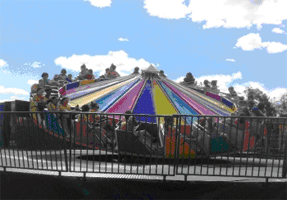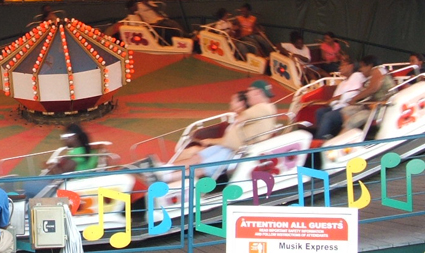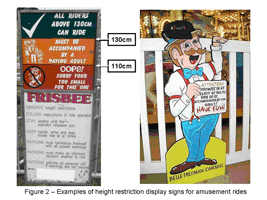Safety of amusement rides
Issued: 29 May 2013
Last Updated: 22 October 2013
Purpose
This safety alert highlights potential risks that have been identified with operating Trabant type (and similar) rides and informs amusement ride operators that engineering controls are to be introduced to prevent riders being ejected.
Background
An amusement device incident, involving the ejection of a five-year-old child from the Frisbee ride (also known as a Trabant ride or UFO, refer to Figure 1a), occurred at Toowoomba in May 2013. Workplace Health and Safety Queensland (WHSQ) investigations are on-going, however the incident has highlighted that further engineering control measures can be implemented to improve rider safety on these rides.
The risk of ejection may also exist on other similar older rides such as the:
- Matterhorn type amusement ride (see Figure 1b)
- Super Satellite (previously UFO)
- Alpine Express
- Burnout
- Giant UFO
- Tango Train
- Love Express
- Raupen Bahn
- Rock and Roll.
Note: The risk of ejection may also exist on amusement rides with names other than those listed above. There may also be some rides with the names listed above that do not have the same risk because their restraint system is quite different.
Figure 1a: Frisbee amusement ride |
Figure 1b: Music Express amusement ride |
Contributing factors
Trabant and Matterhorn type rides spin the riders at high speed while the carriages travel up and down. The design of the rider restraint systems on these rides generally does not allow adjustment for different sized riders.
It is possible that slim patrons, who are at or marginally above the allowable height restriction for the ride, can manoeuvre themselves (or slip) into positions where they can be ejected from the ride, including when:
- there is excess space between the riders' body and the restraint system
- there is excess space between the riders' body and the sides of the seat (e.g. when carriages designed for multiple riders or larger patrons are not filled with the correct number or sized riders)
- the rider is not strong enough to hold on to any part of the carriage (e.g. restraint bar) and avoid being ejected.
Action required
Owners of these rides are to engage engineers (i.e. this may be the engineer who carries out annual inspections) to implement the following:
- Conduct a risk assessment of the existing rider restraint system, assuming that size restrictions are necessary, to determine if:
- the manufacturer has stipulated allowable patron restrictions (e.g. minimum height) and that restrictions are reasonable and are, in the opinion of the engineer, acceptable
- the manufacturer has specified any size or seating restrictions for patrons. The engineer should specify the appropriate restrictions on riders to ensure that the rider restraint system remains effective during the operating cycle of the ride (e.g. patrons must be at least the minimum height to be allowed on the ride)
- there are size and/or seating restrictions and whether on-site screening procedures are adequately documented
- documented procedures exist, that they are included as part of the operator training and are consistently implemented by every operator.
- Introduce engineering control measures to prevent the following situations from occurring to a slim rider, who is at or marginally above the minimum height allowed to go on the ride. Consider if the rider is able to:
- manoeuvre into a position (e.g. both legs onto the seat) where they could be ejected from the ride
- slip under the restraint system and into the foot well of the car where they could be ejected from the ride.
- Add a primary and a secondary lock on the restraint system if not already present. The secondary lock should be independent of the primary lock and the restraint system must stay in the intended closed position in the event that either the primary or secondary lock fails. Riders should not be able to disengage either the primary lock or the secondary lock while the ride is in operation.
- Have the restraint system designed to sound engineering principles (e.g. fasteners used to secure the restraint bars and locking devices must be prevented from unintended loosening when the restraint system is being engaged or disengaged).
- Document the assessment and modifications of the ride (as endorsed by your engineer) and submit the modification to WHSQ to update the design registration for the particular ride. (A copy of this documentation should be kept with the ridefor audit review by work health and safety inspectors).
- Communicate the minimum rider size and seating requirements to workers operating the ride and provide training to these workers so that these requirements are strictly enforced. The owner must take steps to monitor the operation of the ride to ensure that the procedure is being followed diligently by the operator (including height restrictions, refer Figure 2). Failure to enforce the requirement may result in serious injuries.
In applying the risk management process, these situations may be considered as likely occurrences.
Figure 2: Examples of height restriction display signs for an amusement rides |
Further information
Further information may be obtained from the following codes:
- How to manage work health and safety risks code of practice 2021 (PDF, 0.65 MB)
- Managing risks of plant in the workplace code of practice 2021 (PDF, 1.57 MB)
- Managing risk
- Plant design registration
- Modifications to an existing design registration
- WHS Regulators' National Audit Tool for Amusement Devices (PDF, 0.48 MB)
-
Amusement devices code of practice 2023 (PDF, 1 MB)


